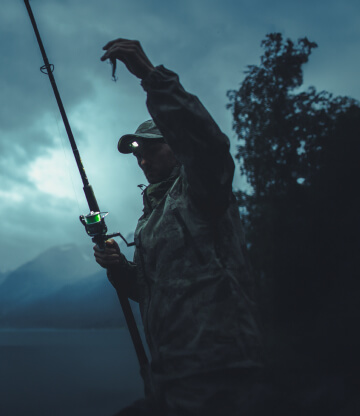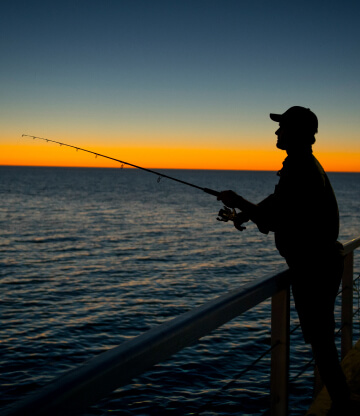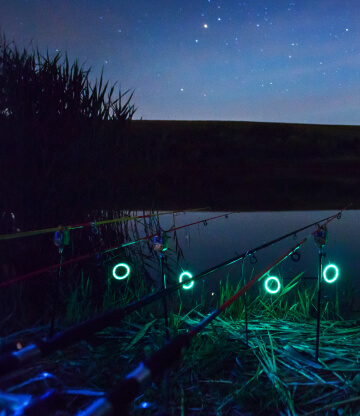Night Fishing for Beginners

Ever wondered what it’s like to cast a line under the stars? Night fishing is an adventure that offers a whole new perspective on your favorite pastime. Whether you’re a seasoned angler or a curious newbie, night fishing opens up a world of possibilities and unique experiences. So, grab your gear, and let’s dive into the ultimate guide to night fishing.
Key Takeaways
- What Fish Can I Catch at Night? — You can catch the same fish at night as you do during the day. However, some species — like catfish, carp, flounder, and grouper — are more active after dark.
- Where to Go Night Fishing — Popular places to go night fishing include piers and beaches, lakes and streams, rivers, inlets, and bays. However, some localities have restrictions on where you can night fish, so be sure to check local regulations.
- When to Night Fish — Summer is the best season for night fishing, but spring and fall can also be effective. Fish just after sunset on nights with mild or cloudy weather, during a full moon or high tide, or before a front. Prime time is typically considered to be between 8 PM and 3 AM.
- Best Baits & Lures for Night Fishing — Reference this table to find the baits and lures that are most effective for night fishing.
- Night Fishing Tips — Read this section to discover expert tips that can make your night fishing adventures more successful and enjoyable.
- Must-Have Night Fishing Gear — In addition to the same fishing gear you use during the day, you’ll need a headlamp or flashlight, first aid kit, life jacket or high-visibility jacket, and underwater lights. You’ll also need bug spray and weather-appropriate clothing.
Why Go Night Fishing?
People go night fishing for a variety of reasons, but the main draw is the unique and tranquil experience it offers. At night, the water is often calmer, and the surroundings are quieter, creating a serene atmosphere. Night fishing allows anglers to escape the daytime crowds and enjoy a more solitary and reflective experience.
This time of day also brings out different fish behaviors; many species are more active and easier to catch after the sun goes down. The thrill of the unknown and the chance to catch a prized fish under the cover of darkness make night fishing an exciting and rewarding adventure.
What Fish Can I Catch at Night?
You can generally target the same fish species when night fishing that you can during the day. However, some fish are more active at night than others due to their individual feeding behaviors. Some of the most popular fish species targeted during night fishing in the U.S. are:
- Saltwater Fish: Snook, flounder, redfish, speckled trout, tarpon, striped bass, snapper, and grouper
- Freshwater Fish: Salmon, coho, chinook, carp, walleye, pike, and catfish
Expert Tip:
Fish species that are sight feeders are less active at night because it’s difficult for them to find food.

Where to Go Night Fishing
You can fish at night in most places you fish during the day, but some states, localities, and areas have restrictions on when you can fish in specific places, such as state parks, reservoirs, and fish management areas. Because of this, you should always check local fishing regulations before selecting your night fishing spot. Some popular places to go night fishing are:
- Piers and Beaches: Many saltwater fish species, including sharks, snook, and tarpon, are more active at night and come closer to shore to feed.
- Lakes: Lakes house a variety of fish species that become more active and feed at night, such as bass, crappie, and walleye. The still waters also make for easier navigation and fishing in the dark.
- Rivers and Streams: The flowing waters bring food and cooler temperatures, which can increase activity in fish like catfish.
- Inlets and Bays: These areas are typically rich in species like flounder, speckled trout, and red drum and provide a calmer environment for fishing compared to open ocean waters.
When to Night Fish
Summer is considered prime time for night fishing because the hot daytime temperatures can make fishing uncomfortable and less productive, driving both anglers and fish to seek relief in the cooler night hours. Fish are more active during these cooler periods, making them more likely to bite.
Spring and fall are also excellent seasons for night fishing because fish are actively preparing for the upcoming summer or winter. This leads to increased fish activity.

Optimal Conditions for Night Fishing
Optimal conditions for night fishing involve a combination of favorable weather, tides, and currents. Ideally, you want to choose a night with mild weather, avoiding heavy winds and storms, which can make fishing difficult and unsafe. Cloudy nights are particularly advantageous because the reduced light makes fish less wary and more likely to venture out in search of food.
Before a front (change in weather, like right before a storm) arrives, fish often become more active and feed aggressively because they sense the change in atmospheric pressure and want to prepare for the upcoming weather. This is a great time to go night fishing, as the increased feeding activity can lead to more bites.
Tides and currents also play a crucial role in night fishing success. Fishing during a rising or high tide is often more productive because many fish species move closer to shore to feed. Currents can stir up the water, dislodging bait and attracting predatory fish. However, strong currents make it challenging to keep your bait in place, so a moderate current is best.
Time of Night
Schedule your night fishing trip around fish feeding behaviors to increase your chances of a successful outing. Fish feed more actively right after sunset because the reduced light provides them with protection from predators. They also tend to feed in shallower waters during this time.
The moon also affects fish feeding behavior. During a full moon, the increased light can extend feeding periods throughout the night, making fish more visible and easier to catch. Conversely, on nights with little to no moonlight, fish may be less active and more cautious.
Overall, most anglers tend to agree that the best time to go night fishing is between 8 PM and 3 AM. However, this timeframe may shift based on the other factors previously discussed.
Expert Tip:
All fish species tend to be more active during full moons.
Best Baits & Lures for Night Fishing
Night fishing requires different baits and lures to be successful than day fishing. We’ve broken them down for you below.
| NIght Fishing Lures & Baits | ||
|---|---|---|
| Lure/Bait | Fish Species | Best For |
Jigging Spoon | Bass, Walleye, Striped Bass, Trout | Deeper water |
Soft Plastic Worms | Bass, Catfish, Panfish, Carp | Shallow water |
Topwater Frogs | Bass, Pike, Musky, Bullhead | Heavy cover and topwater fishing |
Crankbaits | Bass, Walleye, Pike, Musky, Trout | Versatile |
Spinnerbaits | Bass, Pike, Walleye, Musky, White Bass | Murky water |
Lipless Crankbaits | Bass, Pike, Walleye, Striped Bass, Catfish | Shallow and deep water |
Buzzbaits | Bass, Pike, Musky, Carp | Topwater fishing |
Nightcrawler | Catfish, Walleye, Bass, Carp, Trout | Versatile |
Shad Raps | Walleye, Bass, Pike, Trout, Striped Bass | Cold water |
Glow-in-the-Dark Lures | Versatile | Versatile |
Night Fishing Tips
Now that you’re familiar with the allure and timing of night fishing, let’s dive into some practical tips to make your nocturnal angling adventures even more successful.
- Tip 1: Check your gear before you leave to go fishing, While not impossible, it can be difficult to inspect your gear properly in the dark.
- Tip 2: Fish on calm nights right after sunset and during a full moon to take advantage of increased fish activity.
- Tip 3: Arrive at your chosen location before the sun sets to make set up easier and familiarize yourself with your surroundings.
- Tip 4: Fish near ambient light sources (such as dock lights or pier lights) because they attract fish and increase visibility.
- Tip 5: Fish rely mostly on sound and smell to feed at night. Keep your movements to a minimum to prevent scaring fish away.
- Tip 6: Although it’s generally best to stay still, don’t be afraid to choose a new spot if fish aren’t biting in your chosen location.
- Tip 7: Use glow-in-the-dark baits, lures, and lines to attract fish and help you monitor your gear while in use.
- Tip 8: Because visibility is reduced, focus on fishing techniques that attract fish with smell, vibration, and sound.
- Tip 9: Use live bait, fresh-cut dead bait, or fish oils to increase scent and increase the likelihood of fish biting.
- Tip 10: If you’re not using live or fresh-cut dead bait, use dark lures and rattle lures to ensure they stand out from the water.

Must-Have Night Fishing Gear
Aside from your normal fishing gear, there are some products that can make night fishing easier, more enjoyable, and more successful, such as:
- Rechargeable headlamps and flashlights to make rigging your line and reeling in fish easier
- Bug spray to keep mosquitoes and other water insects away
- Weather-appropriate clothing — we recommend bringing layers in case the temperature drops
- A first aid kit to treat any minor injuries
- A high-visibility jacket or life jacket with attached strobe lights or glow sticks if fishing on a boat
- Underwater lights to draw in baitfish, which in turn attract larger predators
Safety and Preparation
When it comes to night fishing, safety and preparedness are paramount. Navigating the darkness brings its own set of challenges, so it's essential to be well-prepared and vigilant. Here are some key tips to ensure a safe and successful night fishing experience:
- Night Vision Preservation: Preserve your night vision by dimming lights and using red-filter flashlights. Red light is less disruptive to your eyes, helping you maintain better visibility in the dark and avoid disorientation on the water.
- Boat Traffic and Safety: Stay vigilant for other boats and understand the meaning of navigation lights to prevent collisions. Be extra cautious around docks and busy areas to ensure your safety and the safety of others on the water.
- Weather Awareness: Monitor the weather forecast and be aware of changing conditions. Sudden weather changes can be more challenging to handle at night, so staying informed helps you avoid dangerous situations.
- Communication Devices: Carry a fully charged phone or a marine radio for emergency communication. In case of any unexpected issues, having a reliable means of communication ensures you can call for help if needed.
Have Fun Out There!
With the right preparation and a bit of patience, night fishing can provide unforgettable experiences and plenty of great stories to share. So, gather your gear, head out under the stars, and discover the allure of fishing after dark. If you need to stock your tackle box before heading out, check out the wide selection of fishing gear and equipment available at Academy Sports + Outdoors!


